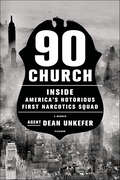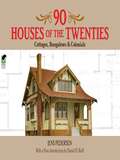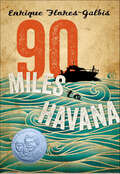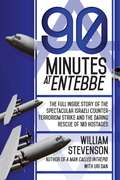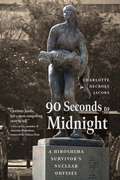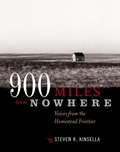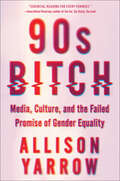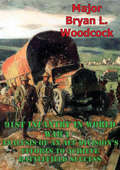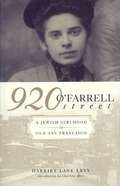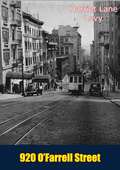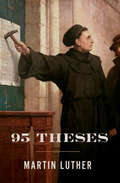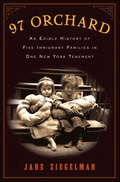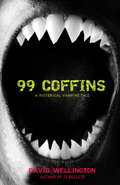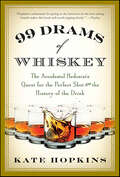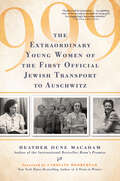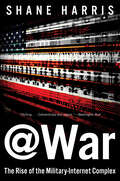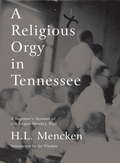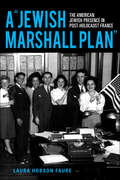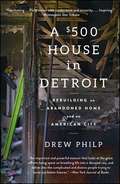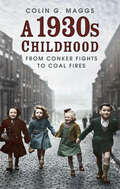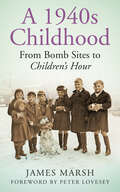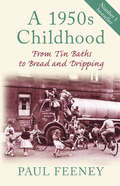- Table View
- List View
90 Church: Inside America's Notorious First Narcotics Squad
by Dean UnkeferMAD MEN MEETS THE WIRE IN THIS GRIPPING TRUE-CRIME MEMOIR BY A FORMER AGENT AT THE FEDERAL BUREAU OF NARCOTICS IN 1960s NEW YORKBefore Nixon famously declared a "war on drugs," there was the Federal Bureau of Narcotics. New York City in the mid-1960s: The war in Vietnam was on the nation's tongue—but so is something else. Clandestine and chaotic, but equally ruthless, the agents of the Bureau were feared by the Mafia, dealers, pimps, prostitutes—anyone who did his or her business on the streets. With few rules and almost no oversight, the battle-hardened agents of the bureau were often more vicious than the criminals they chased. Agent Dean Unkefer was a naive kid with notions of justice and fair play when he joined up. But all that quickly changes once he gets thrown into the lion's den of 90 Church, the headquarters of the Federal Bureau of Narcotics, where he is shocked to see the agents he revered are often more like thugs than lawmen. When he finally gets the chance to prove his mettle by going undercover in the field, the lines become increasingly blurred. As he spirals into the hell of addiction and watches his life become a complex balancing act of lies and half-truths, he begins to wonder what side he is really on. 90 Church is both the unbelievable memoir of one man's confrontation with the dark corners of the human experience and a fascinating window into a little-known time in American history. Learn the story of the agents who make the DEA look like choirboys.
90 Houses of the Twenties: Cottages, Bungalows and Colonials (Dover Architecture)
by Jens Pedersen Daniel D. ReiffThis outstanding house plan catalog from a prominent Midwestern builder was issued on the eve of the Great Depression. Its full-color, beautifully realistic illustrations depict colonials, bungalows, duplexes, and other residences, accompanied by floor plans and detailed descriptions of interiors. A nostalgic look back at the way homes were constructed during the 1920s, this volume offers an authentic resource for modern home restorers, builders, and interior designers and a splendid browsing book for fans of architecture, advertising, and Americana. Architectural historian Daniel D. Reiff provides an informative Introduction.
90 Miles to Havana
by Enrique Flores-GalbisWhen Julian's parents make the heartbreaking decision to send him and his two brothers away from Cuba to Miami via the Pedro Pan operation, the boys are thrust into a new world where bullies run rampant and it's not always clear how best to protect themselves.90 Miles to Havana is a 2011 Pura Belpre Honor Book for Narrative and a 2011 Bank Street - Best Children's Book of the Year.
90 Minutes at Entebbe: The Full Inside Story of the Spectacular Israeli Counterterrorism Strike and the Daring Rescue of 103 Hostages
by William Stevenson Uri DanThe incredible story of an Israeli mission that rescued 103 hostages from a hijacked jetliner.On June 27, 1976, Air France Flight 139 was hijacked by terrorists and flown to Entebbe Airport in Uganda. In the following agonizing days, Israeli passengers were singled out and held hostage. A week later on July 4, one hundred Israeli commandos raced 2,500 miles from Israel to Entebbe, landed in the middle of the night, and in a heart-stopping mission that lasted ninety minutes, killed all guerillas and freed 103 hostages.In captivating detail, Stevenson provides a fast-paced hour-by-hour narration from the hijacking to the final ninety-minute mission. In addition to discussing the incredible rescue itself, Stevenson also covers the political backdrop behind the hijacking, especially Ugandan President Idi Amin’s support for the hijackers, which marked one of the first times a leader of a nation had backed terrorist activities. An illustration of one nation’s undying spirit, heroism, and commitment to its people in the face of threat, Operation Thunderbolt has become a legendary antiterrorist tale.Although first written in 1976 (and published within weeks of the event), Stevenson’s account presents this act of terrorism in a way that is still relevant in our modern-day political climate. A factual account of what could easily be read as sensational fiction, 90 Minutes at Entebbe will inspire, encourage, and instill hope in all readers.Skyhorse Publishing, as well as our Arcade imprint, are proud to publish a broad range of books for readers interested in history--books about World War II, the Third Reich, Hitler and his henchmen, the JFK assassination, conspiracies, the American Civil War, the American Revolution, gladiators, Vikings, ancient Rome, medieval times, the old West, and much more. While not every title we publish becomes a New York Times bestseller or a national bestseller, we are committed to books on subjects that are sometimes overlooked and to authors whose work might not otherwise find a home.
90 Seconds to Midnight: A Hiroshima Survivor's Nuclear Odyssey
by Charlotte DeCroes Jacobs90 Seconds to Midnight tells the gripping and thought-provoking story of Setsuko Nakamura Thurlow, a thirteen-year-old girl living in Hiroshima in 1945, when the city was annihilated by an atomic bomb. Struggling with grief and anger, Thurlow set out to warn the world about the horrors of a nuclear attack in a crusade that has lasted seven decades. In 2015 Thurlow sparked a rallying cry for activists when she proclaimed at the United Nations, &“Humanity and nuclear weapons cannot coexist.&” With that, she shifted the global discussion from nuclear deterrence to humanitarian consequences, the key in crafting the landmark Treaty on the Prohibition of Nuclear Weapons. Regarded as the conscience of the antinuclear movement, Thurlow accepted the 2017 Nobel Peace Prize on behalf of the International Campaign to Abolish Nuclear Weapons. With the fate of humanity at stake and with the resolve of her samurai ancestors, Thurlow challenged leaders of the nuclear-armed states. On January 22, 2021, the Treaty on the Prohibition of Nuclear Weapons went into effect, banning nuclear weapons under international law. Critical historical events need a personal narrative, and Thurlow is such a storyteller for Hiroshima. 90 Seconds to Midnight recounts Thurlow&’s ascent from the netherworld where she saw, heard, and smelled death and her relentless efforts to protect the world from an unspeakable fate. Knowing she would have to live with those nightmares, Thurlow turned them into a force to impel people across the globe to learn from Hiroshima, to admit that yes, it could happen again—and then to take action.
900 Miles from Nowhere: Voices from the Homestead Frontier
by Steven R. KinsellaIt was on the vast American prairie that people from around the world seized the opportunity for personal and economic freedom promised by free land. Traveling across oceans and continents, these hard-nosed, pragmatic people began arriving in the 1860s with shovels and ploughs, convinced they were part of something important. They were. Putting hand to plough and breaking the sod for their first crude homes, these hardy settlers left an indelible thumbprint on American history and on the country's character. Though many of their ventures ended in failure, their risks permanently enhanced the nation's diversity and its sense of independence and resourcefulness. 900 Miles from Nowhere is the heartfelt chronicle of the daily lives and personal struggles of Great Plains homesteaders, told in their own voices through many never-before-published letters, diaries, and photographs. Believing absolutely that they could control their own destiny, they bet everything they owned, even in the face of insurmountable obstacles. This is the remarkable and ever-inspiring story of life on the grasslands that stretch from Canada to Mexico.
90s Bitch: Media, Culture, and the Failed Promise of Gender Equality
by Allison Yarrow“Allison Yarrow takes you back to the era of Anita Hill and Monica Lewinsky and Tonya Harding and examines how the media fueled America’s sexism.”—BustleTo understand how we got here, we have to rewind the VHS tape. 90s Bitch tells the real story of women and girls in the 1990s, exploring how they were maligned by the media, vilified by popular culture, and objectified in the marketplace. Trailblazing women like Hillary Clinton, Anita Hill, Madeleine Albright, Janet Reno, and Marcia Clark were undermined. Newsmakers like Britney Spears, Monica Lewinsky, Tonya Harding and Lorena Bobbitt were shamed and misunderstood. The advent of the twenty-four-hour news cycle reinforced society's deeply entrenched misogyny. Meanwhile, marketers hijacked feminism, sold “Girl Power,” and poisoned a generation. Today echoes of 90s “bitchification” still exist everywhere. To understand why, we must revisit and interrogate the 1990s—a decade in which empowerment was twisted into objectification, exploitation, and subjugation. Award–winning journalist Allison Yarrow’s timely examination is a must-read for anyone trying to understand twenty-first century sexism and end it for the next generation.“Yarrow’s biting autopsy of the decade scrutinizes the way society reduced—or “bitchified”—women . . . Direct quotes from politicians, journalists and comedians about the women provide the most jarring, oh-my-god-that-really-happened portions of Yarrow’s decade excavation.” —Pittsburg Post-Gazette“Allison Yarrow is a feminist and a muckraker in the tradition of Betty Friedan, Naomi Klein, and bell hooks.” —Steve Almond, author of Bad Stories: What the Hell Just Happened to Our Country“Yarrow is a skillful scene setter.” —The Los Angeles Review of Books“‘Essential reading for every feminist.” Anne Helen Petersen, author of Too Fat, Too Slutty, Too Loud
91st Infantry In World War I--Analysis Of An AEF Division's Efforts To Achieve Battlefield Success [Illustrated Edition]
by Major Bryan L. WoodcockIncludes The Americans in the First World War Illustration Pack - 57 photos/illustrations and 10 mapsThe 91st Infantry Division was a National Army Division created prior to World War I. Based at Camp Lewis, Washington, it was composed of draftees from the northwestern United States. Following a train up that lasted less than one year, this division departed for Europe in June 1918.In France, the 91st Division conducted additional training, but the AEF pushed it to the front lines before it was completed. In its first combat experience, the 91st Division fought on the front lines of the Meuse-Argonne. In the first days of this battle, the 91st Division, although inexperienced, gained more ground than any other American division. However, it paid a heavy price in terms of American lives. The AEF subsequently assigned the division to work under French command in the battle of Ypres-Lys in Belgium.This thesis examines the division leadership's ability to execute necessary warfighting functions and combined arms operations in the challenging environment of 1917-1918. The division was tested and accomplished a significant amount, but it also suffered many deficiencies and was forced to learn hard lessons in combat.
920 O'Farrell Street: A Jewish Girlhood in Old San Francisco
by Harriet L. Levy Charlene AkersThe girlhood memoir of Harriet Lane Levy, friend and neighbor of Alice B. Toklas, provides an intimate and detailed glimpse into San Francisco's Victorian past.
920 O’Farrell Street
by Harriet Lane LevyFirst published in 1947, Harriet Lane Levy’s autobiography, 920 O’Farrell Street, chronicles her childhood in an upper-middle-class San Francisco neighborhood during the mid-late nineteenth century—a period in which young women such as Levy were expected to marry well-off men, generating additional societal expectations. The intellectually inclined Levy was hesitant to marry early and instead took herself off to study at the University of California at Berkeley.
94 Maidens
by Rhonda Fink-WhitmanWHEN THE UNIMAGINABLE IS THE ONLY THING LEFT TO DO... They are innocent schoolgirls ranging in age from 14 to 22. Under normal circumstances they should be learning, laughing, and playing. Unfortunately, the year is 1942 and the place is Nazi-occupied Poland. Nothing is normal. On the night of August 11, dressed only in cotton nightgowns, they await their fate at the hands of their Nazi captors. They are no match for the Nazi beast- or are they? Meanwhile, a young Jewish family is caught in a perilous game of cat and mouse with the Nazis in Berlin. How long can they possibly remain among the living? It's getting harder to run, more dangerous to hide. The Nazis are hot on their trail, and time is running out for both the hunters and the hunted. Rhonda is a successful television personality and a well-respected Jewish educator. With her aging mother still suffering scars left by the Holocaust some 70 years later, she decides it's time to go to Germany, where she pitches her way inside the largest Nazi archive the world has never seen in an attempt to discover the truth about what happened to her mother during WWII. Will the secrets she unveils help heal her mother's wounded soul? Or will the answers to her questions change everything she ever thought she knew about her family, her mother, and herself? Inspired by true events, 94 Maidens is an unforgettable story of heroism, resistance, martyrdom, and survival.
95 Theses: Sermon On Indulgences And Grace, 95 Theses (Treasures Of The Taylorian: Reformation Pamphlets Ser. #Vol. 2)
by Martin LutherThe sixteenth-century document that changed the course of Christianity. Monk and theology professor Martin Luther found himself in disagreement with the Roman Catholic Church on the subject of indulgences—certificates sold by the Church that promised to spare their owners from punishment for their sins. With his 95 Theses, Luther proposed a debate on the subject, but ultimately, he was excommunicated and the Protestant Reformation began. This is both a religious document and a historical one—a turning point that marked a challenge to papal authority, set off political conflicts and bloody war in Europe, and led to the remarkable variety of Christian denominations and sects that exist in the world today.
97 Orchard: An Edible History of Five Immigrant Families in One New York Tenement
by Jane Ziegelman“Social history is, most elementally, food history. Jane Ziegelman had the great idea to zero in on one Lower East Side tenement building, and through it she has crafted a unique and aromatic narrative of New York’s immigrant culture: with bread in the oven, steam rising from pots, and the family gathering round.” — Russell Shorto, author of The Island at the Center of the World 97 Orchard is a richly detailed investigation of the lives and culinary habits—shopping, cooking, and eating—of five families of various ethnicities living at the turn of the twentieth century in one tenement on the Lower East Side of Manhattan. With 40 recipes included, 97 Orchard is perfect for fans of Rachel Ray’s Hometown Eats; anyone interested in the history of how immigrant food became American food; and “foodies” of every stripe.
99 Coffins (Laura Caxton #2)
by David WellingtonLaura Caxton vowed never to face them again. The horror of what the vampires did is too close, the wounds too fresh. But when Jameson Arkeley, broken and barely recognisable, comes to her with an unfathomable, unholy discovery, her resolve crumbles. Arkeley leads Caxton to a tomb in Gettysburg recently excavated by a local archaeology professor. While the town, with its legendary role in the Civil War's worst battle, is no stranger to cemeteries, this one is remarkably, eerily different. In it lie 100 coffins - 99 of them occupied by vampires, who, luckily, are missing their hearts. But one of the coffins is empty and smashed to pieces. Who is the missing vampire? Does he have access to the 99 hearts that, if placed back in the bodies of their owners, could reanimate an entire bloodthirsty army? How did the vampires end up there, undisturbed and undiscovered for 150 years? The answer lies in Civil War documents that contain sinister secrets about the newly found coffins - secrets that Laura Caxton is about to uncover as she is thrown into a deadly, gruesome mission of saving an entire town from a mass invasion of the undead . . .
99 Drams of Whiskey: The Accidental Hedonist's Quest for the Perfect Shot and the History of the Drink
by Kate HopkinsKate Hopkins knew there had to be more to whiskey than using it as a mixer. She had an unquenchable thirst to learn more about "the drink" and set out on an ambitious itinerary researching its history. Combining comprehensive research with informal narrative, Hopkins entertains and educates the readers on whiskey's place in the history of the world. She visited historians and pub owners, went to distilleries owned by corporations who sell thousands of gallons per day, and artisans who sell thousands of gallons per year, and interviewed the aficionados and the common drinkers, because one of the best aspects of whiskey is not just its taste, but the stories about the drink that are told around the bar. As an added bonus, she discusses the fine art of distilling, the proper ways to drink whiskey, and provides tasting notes on different brands, all in the hope of discovering the best shot of the liquor.
999: The Extraordinary Young Women of the First Official Jewish Transport to Auschwitz
by Heather Dune MacadamA Goodreads Choice Awards Nominee An Amazon Best of the Year SelectionThe untold story of some of WW2&’s most hidden figures and the heartbreaking tragedy that unites them all. Readers of Born Survivors and A Train Near Magdeburg will devour the tragic tale of the first 999 women in Auschwitz concentration camp. This is the hauntingly resonant true story that everyone should know. On March 25, 1942, nearly a thousand young, unmarried Jewish women boarded a train in Poprad, Slovakia. Filled with a sense of adventure and national pride, they left their parents&’ homes wearing their best clothes and confidently waving good-bye. Believing they were going to work in a factory for a few months, they were eager to report for government service. Instead, the young women—many of them teenagers—were sent to Auschwitz. Their government paid 500 Reich Marks (about $200) apiece for the Nazis to take them as slave labor. Of those 999 innocent deportees, only a few would survive. The facts of the first official Jewish transport to Auschwitz are little known, yet profoundly relevant today. These were not resistance fighters or prisoners of war. There were no men among them. Sent to almost certain death, the young women were powerless and insignificant not only because they were Jewish—but also because they were female. Now acclaimed author Heather Dune Macadam reveals their poignant stories, drawing on extensive interviews with survivors, and consulting with historians, witnesses, and relatives of those first deportees to create an important addition to Holocaust literature and women&’s history. Includes a foreword by Caroline Moorehead, NYT bestselling author of A Train in Winter! &“A fresh, remarkable story of Auschwitz on the 75th anniversary of its liberation. An uplifting story of the herculean strength of young girls in a staggeringly harrowing situation.&” —Kirkus &“Intimate, harrowing… This careful, sympathetic history illuminates an incomprehensible human tragedy.&” —Publishers Weekly
: Essays on the Late Writings of Robert Duncan (Modern and Contemporary Poetry and Poetics)
by James MaynardThis collection of essays focuses on the remarkable late writings of Robert Duncan. Although praised by reviewers, Duncan's last two books of poetry have yet to receive the critical attention they merit. Written by a cast of emerging and established scholars, these essays bring together a diverse set of approaches to reading Duncan's writing.
@War: The Rise of the Military-Internet Complex
by Shane HarrisAn informative study of how corporations, governments, and individuals are perfecting the ability to monitor and sabotage Internet infrastructure.The wars of the future are already being fought today. The United States military currently views cyberspace as the “fifth domain” of warfare (alongside land, air, sea, and space), and the Department of Defense, the National Security Agency, and the CIA all field teams of hackers who can, and do, launch computer virus strikes against enemy targets. As recent revelations have shown, government agencies are joining with tech giants like Google and Facebook to collect vast amounts of information, and the military has also formed a new alliance with tech and finance companies to patrol cyberspace. Shane Harris offers a deeper glimpse into this partnership than we have ever seen before, and he explains what the new cyber security regime means for all of us who spend our daily lives bound to the Internet—and are vulnerable to its dangers.
A Religious Orgy in Tennessee
by H. L. Mencken Art Winslow"The native American Voltaire, the enemy of all puritans, the heretic in the Sunday school, the one-man demolition crew of the genteel tradition." -Alistair Cooke on H.L. Mencken Fiercely intelligent, scathingly honest, and hysterically funny, H.L. Mencken's coverage of the Scopes Monkey Trial so galvanized the nation that it eventually inspired a Broadway play and the classic Hollywood movie Inherit the Wind. Mencken's no-nonsense sensibility is still exciting: his perceptive rendering of the courtroom drama; his piercing portrayals of key figures Scopes, Clarence Darrow, and William Jennings Bryan; his ferocious take on the fundamentalist culture surrounding it all--including a raucous midnight trip into the woods to witness a secret "holy roller" service. Shockingly, these reports have never been gathered together into a book of their own--until now. A Religious Orgy In Tennessee includes all of Mencken's reports for The Baltimore Sun, The Nation, and The American Mercury. It even includes his coverage of Bryan's death just days after the trial--an obituary so withering Mencken was forced by his editors to rewrite it, angering him and leading him to rewrite it yet again in a third version even less forgiving than the first. All three versions are included, as is a complete transcript of the trial's most legendary exchange: Darrow's blistering cross-examination of Bryan. With the rise of "intelligent design," H.L. Mencken's work has never seemed more unnervingly timely--or timeless.
A "Jewish Marshall Plan": The American Jewish Presence in Post-Holocaust France (The Modern Jewish Experience)
by Laura Hobson FaureWhile the role the United States played in France's liberation from Nazi Germany is widely celebrated, it is less well known that American Jewish individuals and organizations mobilized to reconstruct Jewish life in France after the Holocaust. In A "Jewish Marshall Plan," Laura Hobson Faure explores how American Jews committed themselves and hundreds of millions of dollars to bring much needed aid to their French coreligionists. Hobson Faure sheds light on American Jewish chaplains, members of the Armed Forces, and those involved with Jewish philanthropic organizations who sought out Jewish survivors and became deeply entangled with the communities they helped to rebuild. While well intentioned, their actions did not always meet the needs and desires of the French Jews. A "Jewish Marshall Plan" examines the complex interactions, exchanges, and solidarities created between American and French Jews following the Holocaust. Challenging the assumption that French Jews were passive recipients of aid, this work reveals their work as active partners who negotiated their own role in the reconstruction process.
A "Topping People"
by Emory G. EvansA "Topping People" is the first comprehensive study of the political, economic, and social elite of colonial Virginia. Evans studies twenty-one leading families from their rise to power in the late 1600s to their downfall over one hundred years later. These families represented the upper echelons of power, serving in the upper and lower houses of the General Assembly, often as speaker of the House of Burgesses. Their names--Randolph, Robinson, Byrd, Carter, Corbin, Custis, Nelson, and Page, to note but a few--are still familiar in the Old Dominion some three hundred years later.Their decline was due to a variety of factors--economic, social, and demographic. The third generations showed an inability to adapt their business philosophies to the changing economic climate. Their inclination was to mirror the English landed gentry, living off the income of their landed estates. Economic diversification was the norm early on, but it became less effective after 1730. Scots traders, for example, introduced chain stores, making it more difficult to continue family-run stores. And land speculation was no substitute for diversification. An increase in population resulted in the creation of new counties, which weakened the influence of the Tidewater region. These leading families began to spend more than they earned and became heavily indebted to British mercantile firms. The Revolution only served to make matters worse, and by 1790 these families had lost their political and economic status, although their social status remained. A "Topping People" is a thorough and engrossing study of the way families came to gain and, eventually, lose great power in this turbulent and progressive period in American history.
A $500 House in Detroit: Rebuilding an Abandoned Home and an American City
by Drew PhilpDrew Philp, an idealistic college student from a working-class Michigan family, withdraws from the comforts of life on a university campus in search of a place to live where he can make a difference. He sets his sights on Detroit, the failed metropolis of abandoned buildings, widespread poverty, and rampant crime—a complicated source of national fascination, often stereotyped and little understood. Arriving with no job, no friends, and no money, Philp is naïvely determined to fix the huge, broken city with his own hands and on his own terms. A year later, he saves up and buys a ramshackle house for five hundred dollars in the east side neighborhood known as Poletown and moves in. Philp gets what he pays for. The roomy Queen Anne he now owns has been abandoned for a decade and is little more than a clapboard shell on a crumbling brick foundation, filled with heaping piles of trash (including most of a chopped-up minivan), and missing windows, heat, water, electricity, and a functional roof. The landscape of the surrounding neighborhood resembles an urban prairie: overgrown fields dotted with houses that haven’t been demolished or burned to the ground—some of them well-maintained by Detroiters who have chosen to remain in the city, but many, like the Queen Anne, left vacant and in complete disrepair. Based on a BuzzFeed essay that resonated with millions of readers, A $500 House in Detroit is Philp’s raw and earnest account of rebuilding everything but the frame of his house, nail by nail and room by room. It’s also the story of a young man finding his footing in the city, the country, and his own generation. As he assimilates into the community of Detroiters around him, Philp guides readers through the city’s vibrant history and engages in urgent conversations about gentrification, racial tensions, and class warfare. We witness his concept of Detroit shift, expand, and evolve as his plan to save the city gives way to a life forged from political meaning, personal connection, and collective purpose. Part social history, part brash generational statement, part comeback story, A $500 House in Detroit is an intimate account of the tentative revival of an American city—home by home and person by person—and a glimpse at a new way forward for generations to come.
A 1930s Childhood: From Conker Fights to Coal Fires
by Colin G. MaggsDo you remember collecting birds’ eggs and cigarette cards? Or the first appearances of wrapped sweets like Mars and Milky Way?The 1930s was a time of great progress, as engines took over from horses, and electric light from gas and oil. In the background, change was everywhere, with the Mallard speed record, the abdication of the King, and the increasing spectre of the impending Second World War. It was a time of home cooking, and day-trip holidays, when families kept chickens and children played with bows and arrows.This delightfully nostalgic book will take you right back to a different age, recalling what life was like for those growing up in the 1930s.
A 1940s Childhood: From Bomb Sites to Children's Hour
by Peter Lovesey James MarshDo you remember collecting shrapnel and listening to Children’s Hour? Carrying gas masks or sharing your school with evacuees from the city? The 1940s was a time of great challenge for everyone who lived through it. From the hardships and fear of a World War, with Britain’s towns and cities were being bombed on an almost nightly basis, to the trauma of being parted from ones parents and sent away to the country to live with complete strangers. For just over half of this decade the war continued, meaning food and clothing shortages became a way of life. But through it all, and afterwards, the simplicity of kids shone through. From collecting bits of shot down German aircraft to playing in bomb-strewn streets, kids made their own fun. Then there was the joy of the second half of this decade when fathers came home and fun things started up again. This trip down memory lane will take you through the most memorable and evocative experiences of growing up in the 1940s.
A 1950s Childhood: From Tin Baths to Bread and Dripping
by Paul FeeneyDo you remember PathÉ News? Taking the train to the seaside? The purple stains of iodine on the knees of boys in short trousers? Knitted bathing costumes? Then the chances are you were born in or around 1950. To the young people of today, the 1950s seem like another age. But for those born around then, this era of childhood feels like yesterday. This delightful collection of photographic memories will appeal to all who grew up in this post-war decade; they include pictures of children enjoying life out on the streets and bombsites, at home and at school, on holiday and at events. These wonderful period pictures and descriptive captions will bring back this decade of childhood, and jog memories about all aspects of life as it was in post-war Britain.
